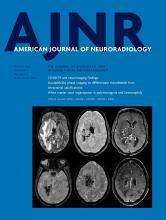With great interest, we read the article “Cerebellar Watershed Injury in Children.”1 The authors described 23 children with focal signal abnormalities in the depth of cerebellar fissures and hypothesized watershed injury as their presumed mechanism, in opposition to “bottom-of-fissure” dysplasia. We have occasionally encountered similar cerebellar imaging findings in children, and we have also ascribed these to watershed ischemia instead of cortical dysplasia.
The authors described 4 reasons to hypothesize that the pathologic basis for the “depth-of-fissure” MR imaging sign is cerebellar watershed injury rather than a congenital malformation: 1) location at the deep borderzones, 2) association with supratentorial watershed infarcts, 3) restricted diffusion in the acute phase, and 4) frequent late foliar volume loss with fissural prominence.1
In this letter, we would like to further support this hypothesis by comparison with the MR imaging appearance of cerebellar infarcts observed in adults. In 2015, we published the 3D MR imaging patterns of cerebellar infarcts with respect to anatomic boundaries, including fissures,2 because we had renounced the traditional borderzone classification because of the high interindividual variability of perfusion territories and thus borderzones.3,4 In essence, in an anatomic MR imaging study of 138 cerebellar infarcts observed in 70 different patients, we found that the overwhelming majority of cerebellar infarcts involved the cortex and most often occurred in the apex of cerebellar fissures; 47% of cortical infarcts involved the apex of a large fissure, and 11%, of a smaller fissure.2 In larger infarcts, the apexes of multiple adjacent fissures were seen to be involved, also in the same way as in children.2 Last and also analogous to the recent MR imaging findings in children, the cerebellar vermis was seen, in our study, to be spared in >90% of infarcts.2
Although we used the term “apex of a fissure,” this corresponds to the same typical imaging pattern of bottom-of-fissure or depth-of-fissure infarct with involvement of the cortex and sparing of the subjacent white matter. In a postmortem 7T radiologic-pathologic correlation study, we confirmed the ischemic origin and cortical predilection of these lesions, typically with only microscopic changes in the subjacent white matter.5 Finally, in 2 more studies, we correlated these cortical infarcts with markers of cerebrovascular disease and vertebral artery stenosis and found that the same infarcts may demonstrate an atherothrombotic as well as a thromboembolic origin.6,7
In conclusion, the depth-of-fissure sign, which is best appreciated in the coronal or sagittal plane, is an easy MR imaging sign to diagnose cerebellar infarcts in all stages and applies to adults in addition to children. This interesting similarity between cerebellar infarcts observed in children with watershed injuries compared with adults with arterial thromboembolism may add evidence to an older hypothesis that hypoperfusion and thromboembolism are not mutually exclusive, but rather complementary and interrelated instead.8
References
- © 2020 by American Journal of Neuroradiology











